#why was this a trend in the late 80s-early 90s
Text

I’m making a list
#beaches#steel magnolias#fried green tomatoes#why was this a trend in the late 80s-early 90s#why didn’t any of them kiss#to be fair fried green tomatoes does seem more intended than the others#but still no smooches#make it gay you cowards
104 notes
·
View notes
Text
Everyone gets “The 90s” look wrong and I hate it
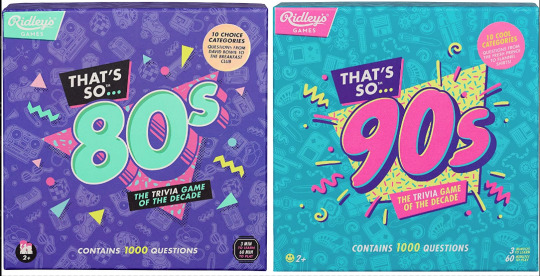
Couple years ago I saw these two board games at the store back to back. Well, not saw them per se, but ya know. Spied them out of the corner of my eye. And for a moment without reading the text, I couldn’t tell you which was which decade at first. Funny. Either they were in a rush to get these out the door or they wanted their throwback trivia game boxes to look uniform. I didn’t think too much of it.
Only, from then on I started seeing it MORE. Every time someone markets a 90s or 80s throwback...
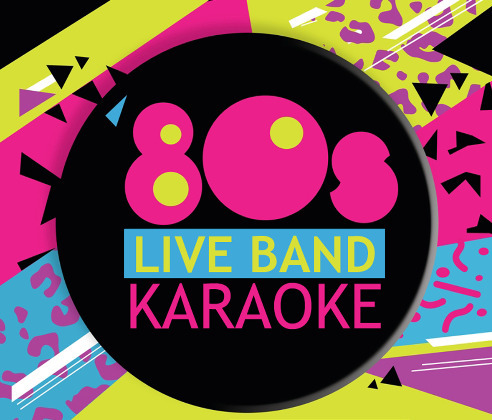
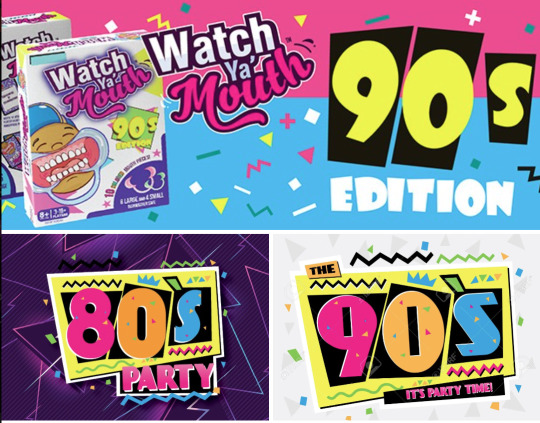
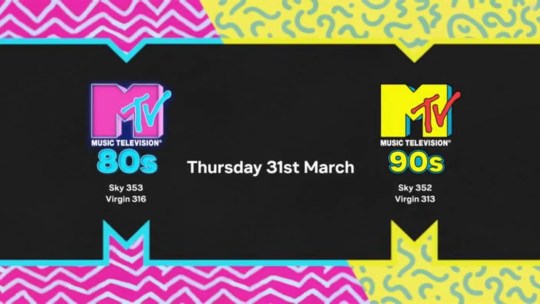

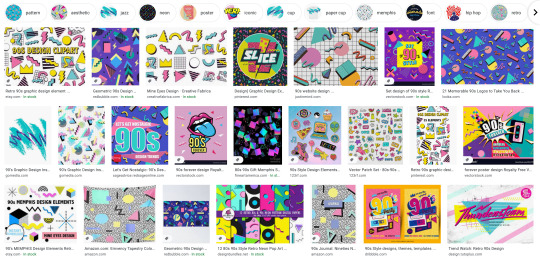
Goddammit they’re identical! What??! How did we let this happen? As a 90s survivor and a designer, this drives me up a wall.
Look, I know I’m late to the party to complain about “the 90s look” when we’re just starting to get sick of the Y2K nostalgia train. But c’mon, the 90s were not The 80s: Part Two™
Trust me when I say that we weren’t all wearing neon trapezoids up until the year 2000. The 90s look being peddled is so specific to the tail end of the 80s and an early early part of the 90s - a part of the 90s when it wouldn’t stop being the 80s. This is Memphis design being conflated with the wrong decade.
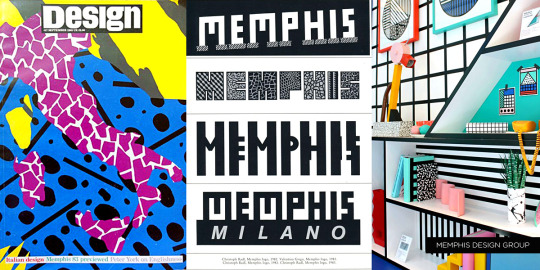

Keep reading for a long ass graphic design history lesson and pictures of old soda and fast food.
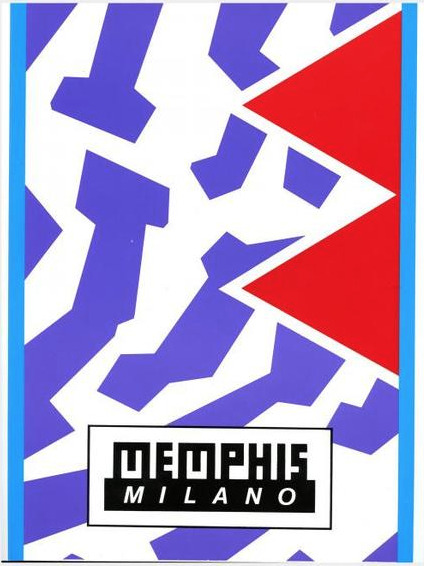
Specifically, the look is Memphis Milano, self-named by the Italian design house Memphis Group. Starting in the early to mid 80s, they made all sorts of furniture, fabrics and sculptures that were like a Piet Mondrian grid painting under heavy radiation. Their whole deal was defying the standards of existing industrial design up to that point on purpose. Chairs had weird arches, bookcases would be in strange alien colors, unusual materials like plastic or elastic were used in place of metal or wood, that sorta thing.

Memphis quickly became the signature look for the decade. You can tell something’s influenced by Memphis design from it’s telltale trademarks:
Clashing, neon colors.
Use of diametric shapes.
Contrasting patterns like zebra print stripes, confetti squiggles and checkerboards.
It wasn’t long before Memphis Milano-inspired design was everywhere in 80s pop culture:







It was a special time, yes.
I was a kindergartener at the tail end of the 80s, so I knew Memphis mostly through the lens of kids media. Toys, clothes, games, tv shows used it like candy colored catnip. Cable channel Nickelodeon more or less adopted the Memphis aesthetic as their signature in-house style and practically built a monument to it at a Florida theme park:
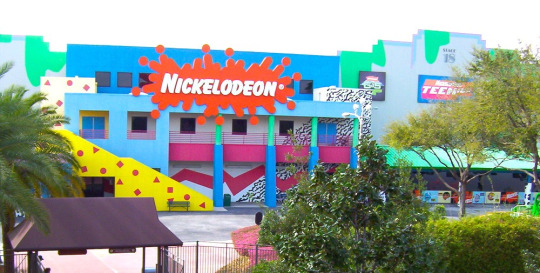
I think this is why folks mistake what decade Memphis is representative of - 90s staples like Nick, Saved By The Bell, Fresh Prince - they all stayed around much longer than the design trend’s expiration date.



Couple that notion with the fact that companies are slow followers to design trends. Something gets popular and they want to get on the bandwagon? Gotta wait for the ink to dry, gotta wait for the production molds to be made. It would take a few years for them to completely work Memphis outta their system.

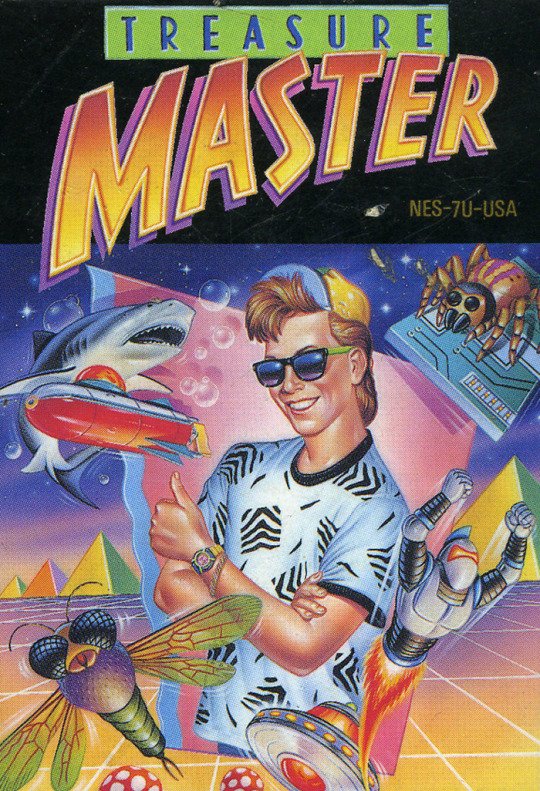

Now, this is not to say Memphis is bad! Personally I’m a fan of the aesthetic, if my neon-drenched artwork wasn’t a tip-off already. But it is a trend, and trends never last forever.
So what took the Memphis Milano look down for good? This part’s up for debate, but I personally think it had something to do with this dude:
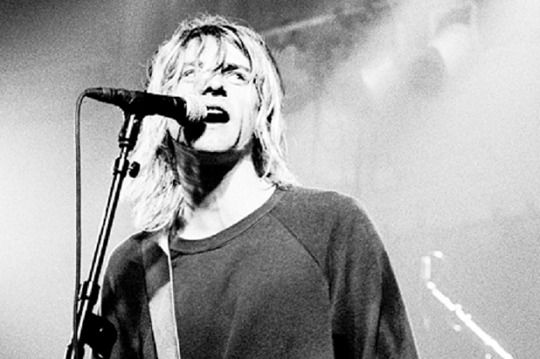
It’s that grunge music from Seattle that’s so popular with the kids these days dontchaknow.
Once Smells Like Teen Spirit hit in 1991, the Nirvana tone drove the rest of the decade. Clean geometry became weathered, grainy and organic. Bright neon pastels became more bold. Bubblegum pop music sounded fake and manufactured. Attitude and apathy was authentic. Whatever.
Things got grungy. Things got grimy. Olestra was invented.
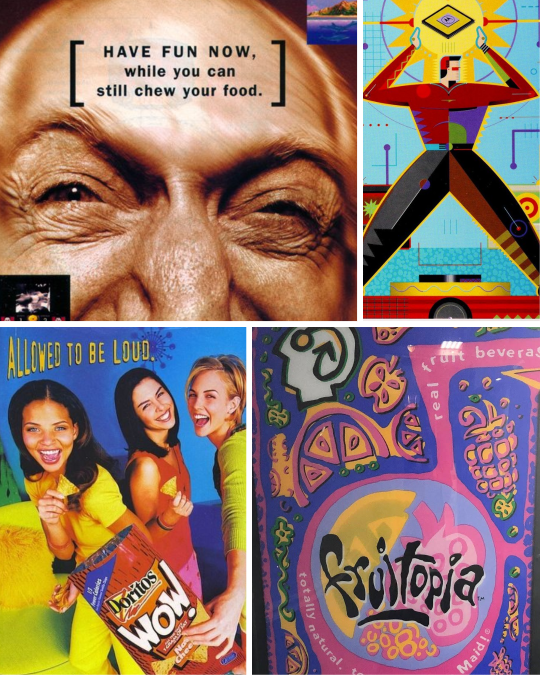
I think the best way to visualize this transition is how Cherry Coke entered the decade and how it left it:
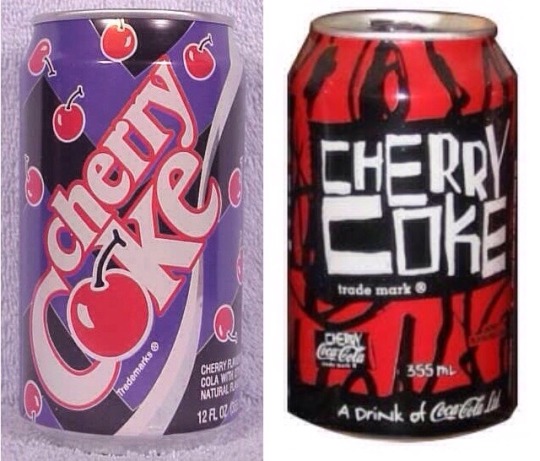
1992 Memphis on the left, 1998 grunge junkie on the right. Fitting that the 90s would end with a design that looked like Darth Maul’s lungs.
Okay, so what should 90s retro design look like?
Continue on to PART TWO! Spoilers: No VHS filters or vaporwave needed, but maybe bring an antacid.
15K notes
·
View notes
Text
Mini Lolita Fashion History Lesson: MILK
Today, MILK is generally known as an 'otome' or 'girly' brand, and many of their modern items don't look like what modern lolita think of as lolita.
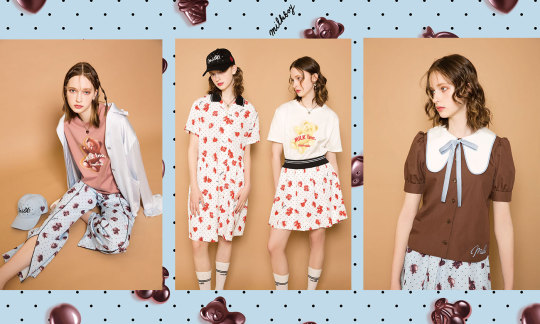
A recent MILK collection
However, in the late 80s and early 90s, MILK was considered to be one of the quintessential Lolita brands.


1990s lolita wearing MILK
In a 1994 zipper interview about the history of lolita fashion the brand representative for MILK states "I think what is now called lolita fashion is the fashion that milk has been making for a long time."
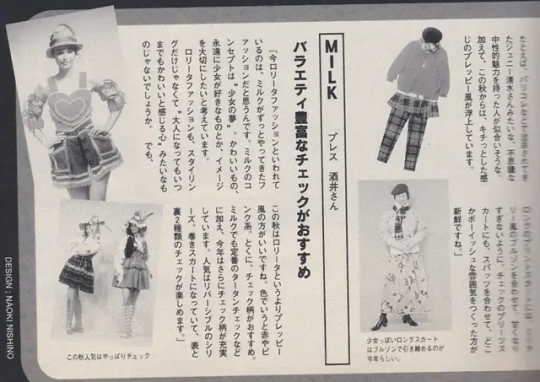
MILK was founded in 1970 by Hitomi Okawa (大川ひとみ). When Hitomi Okawa started as a designer there were not many DC brands yet and ready to wear fashion was really just starting to become more widespread in Japan. Okawa attended an art university in Kyoto because of a love of drawing that started in elementary school. She used to draw illustrations of girls and make things like paper dolls. At the age of 11, she drew many pictures of the same clothes and changed the patterns (polka dots, checks, flowers). She grew up the daughter of a doctor, in an affluent home where her mother would read magazines like Harper's Bazaar with 1950s and 1960s American fashion. She also looked at American fashion catalogs as a child, and cites this study of clothing in magazines and catalogs as her earliest sort of "studying" of fashion.

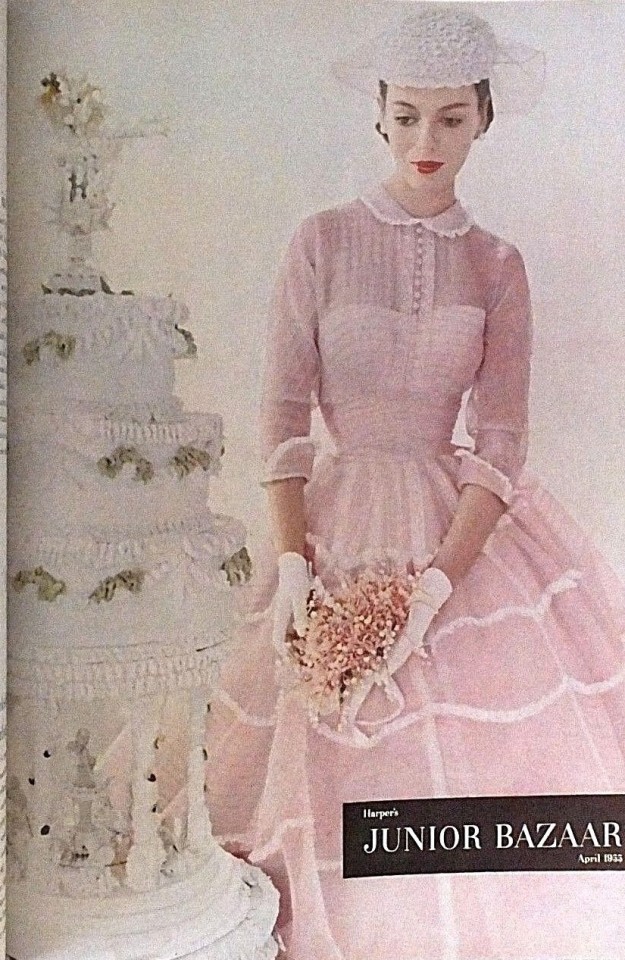
50s/60s Harper's Bazaar
In addition to drawing inspiration from the 50s & 60s Harper's Bazaar & American clothing catalogs, she also drew inspiration from military uniforms and how they have custom buttons and custom fabric and details like that, as well as current trends in London and Tokyo as the brand continued to develop. When she started however, she says that she was the only one making this sort of cute girly clothing in Japan and she felt like she had to make it because no one else was making what she wanted to wear.
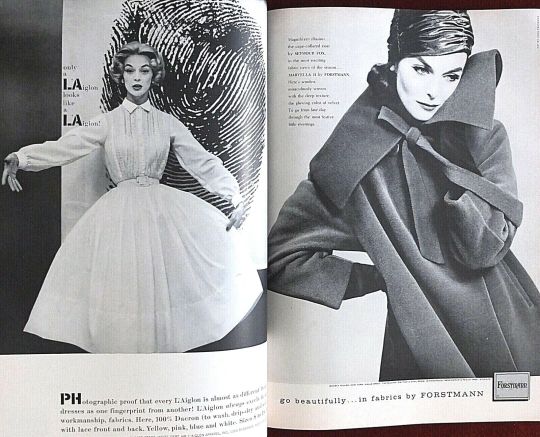

50s/60s Harper's Bazaar
After graduating from Seian College of Art and Design, Department of Design, she started MILK in Harajuku. She wanted to start in the coolest place possible, so she decided on Central Apartment.

MILK Shop Front in the 70s, Central Apartment
She had come to Harajuku when she was either in High School or her first year of University and had stood in the middle of the pedestrian bridge right off Harajuku station, and she looked down at Omotesando and thought "Here is the coolest place, I want to be here!", and that's why she chose that location. The Bridge doesn't exist any more, it was torn down in 2011. She wasn't aware at the time that Central Apartment was a popular place for creators, she just thought that street was nice and that Central Apartment was modern and cool. In a 2021 interview she confessed that she sometimes still goes up to the pedestrian bridge on the Yoyogi Park side and looks at Omotesando, and when she does, she feels the same way she did when she was 20 years old.
Central Apartment (原宿セントラルアパート) was initially an apartment complex built in Harajuku in 1958 at the intersection of Meiji-dori. It was initially built for special international travelers like US military personnel. In the mid 1960s/early 1970s, the lower floors were converted into stores with offices in the upper apartment floors.
The Coffee shop Leon on the first floor was a popular spot with creative people. There were also shops like Mademoiselle Nonnon launched by designer Taro Aramaki which sold French style clothing and lots of horizontal stripes. Mademoiselle Nonnon is considered to be the source of the border (horizontal stripe) trend in Japan.
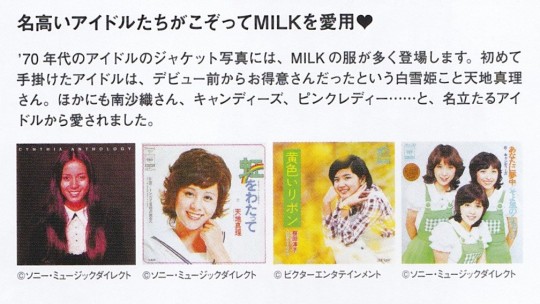
Initially, "MILK", was expensive and unrealistic for everyday wear, so it was mainly used as a stage costume for idols, however, people started wearing Milk as everyday clothing as time went on.
MILK also experimented with a Bridal line in the 70s as well.
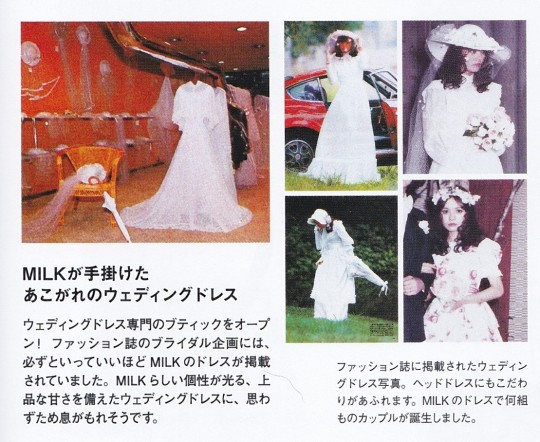
While their runway looks were generally a bit more loud than the way the pieces would have been worn in real life, you can see some prairie revival influence their early 70s items as well as some silhouettes in the '76 collection that are starting to look more lolita-esque.
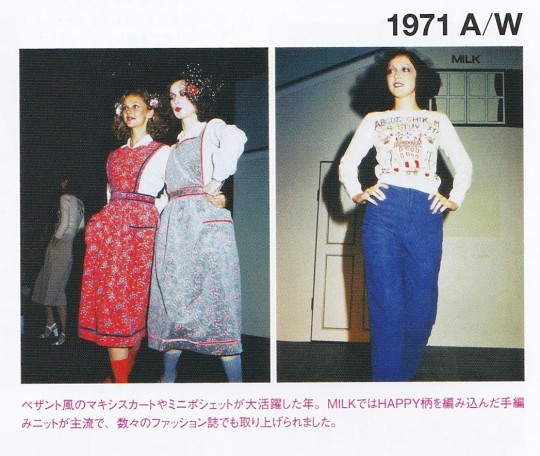
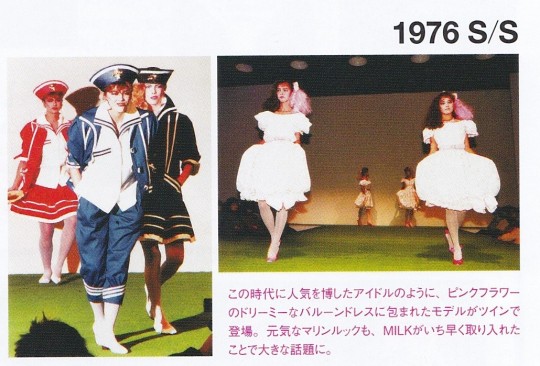
Here are a few runway examples from the 1980s, note the border print of a carousel in the 1988 collection and the knee length ruffled skirt in the 1982 one.
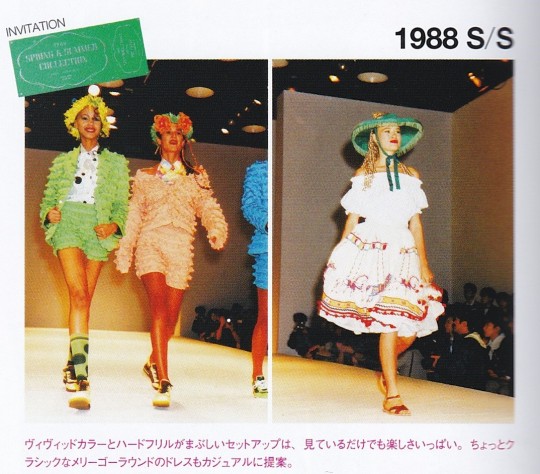

By the early 1990s, MILK was heavily featured in coordinates worn by young women who considered themselves lolita in magazines like Cutie and Zipper, and was also advertising in those magazines.
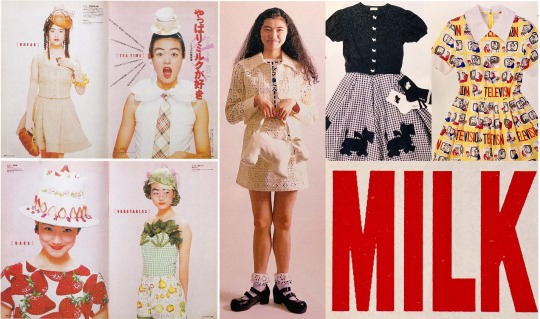
1990-1992 Cutie advertisements for MILK
Early 1990s looks from MILK were fairly consistent with what was on offer from similar shops like PRETTY and Shirley Temple.



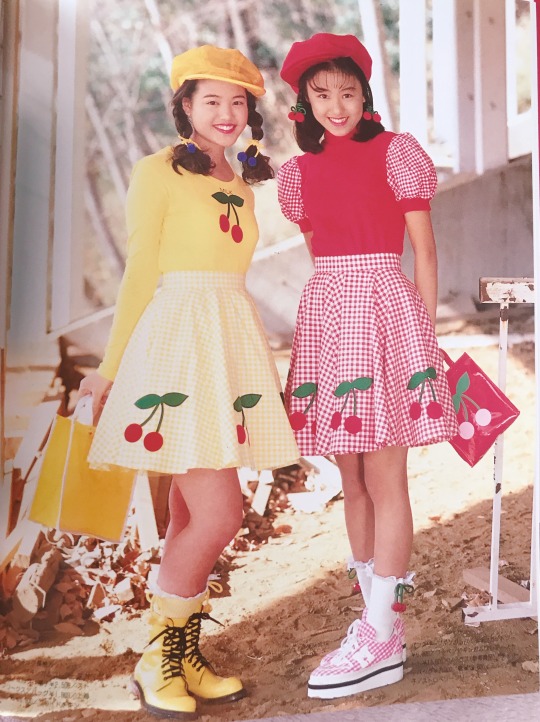
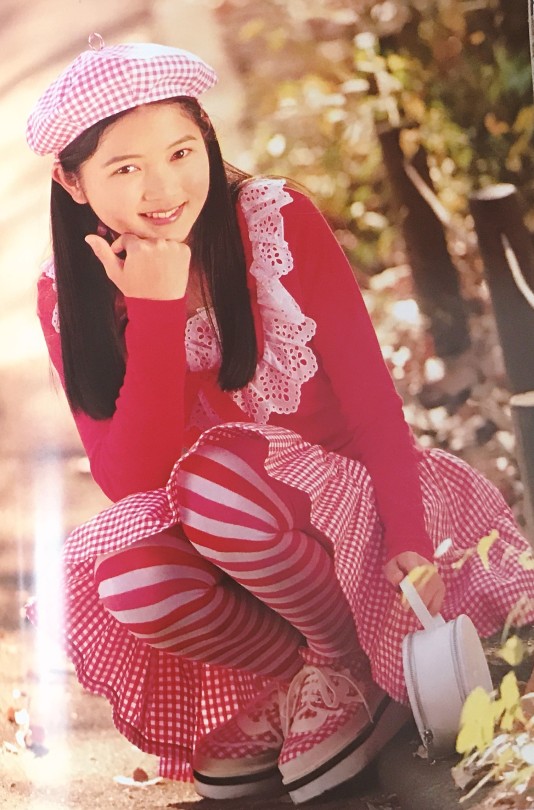

MILK Coordinates from Nene magazine, 1995
Speaking of Shirley Temple, the founder of Shirley Temple, Rei Yanagawa (柳川れい), worked as a designer for MILK before starting the Shirley Temple children's brand in 1974.
As time went on, lolita fashion started to diverge from the MILK style, while MILK followed their own design concept and look more at current trends in girly fashion. Today, some iconic MILK items like their heart purse are still frequently used in lolita fashion, however, it would be difficult to walk into MILK today and put together a coordinate that would read the same as one made from items at Angelic Pretty.
While goth and punk brands typically have no issue relating themselves to goth or punk fashion, brands popular with lolita have sometimes resisted self-describing themselves as lolita, most likely in an attempt to not alienate non lolita customers, due to lolita fashion having a mixed reputation. MILK, like many other Japanese brands, especially DC brands, maintains that they make MILK style, even though their influence on what we call lolita fashion today, is unmistakable.
Past Posts:
Olive Girls
#MILK#Old School Lolita#Lolita Fashion History#Shirley Temple#90s Jfashion#80s Jfashion#70s Jfashion#Lolita History#Central Apartment#Hitomi Okawa#Mini Lolita History Lesson
323 notes
·
View notes
Text
TF Rise of the Beasts: A Basic Guide to Writing/Drawing for Fashion in 1994
Someone sent me a message that has now disappeared (!!) which was asking for some tips on what was stylish in 1994, for the purposes of writing a time period accurate ROTB fic.
I'm sorry I don't remember their username otherwise I'd tag them, but I figured I'd provide some notes here just in case anyone else might find it helpful for ROTB fic writing or fanart! :)
1994 Style: The Coolest Magazines
So as far as I remember, there were three big fashion/culture magazines at the time:
Sassy Magazine - This one was aimed mostly at women, but was hugely popular and would be a good place to look for styles for Elena!
i-D Magazine - This is a British publication but had international distribution by the 90s. Most of their early 90s issues featured fashion shoots from both large brands and indie fashion houses, with an emphasis on styling outfits. The articles were pretty good, and covered pop culture, music, and other similar topics. This one includes styles for both men and women, and was one of the only mainstream magazines to include what would now be recognised as queer fashion (they featured Boy George etc. as cover models, too).
The Face - This one is also British but had international distribution, mostly in large cities like LA and New York (which means it's fine to reference for ROTB's setting). Similar to i-D, it featured articles on fashion, music, culture, and highlighted some subculture styles which were harder to find in other more popular magazines like Vogue at the time. This included more "casual" outfits being featured, typically as part of style guides. This one had men and women's fashion, and also featured queer celebrities or genderbending style!
And of course, any magazines from 1994 would be good to look through-- Just keep in mind that magazines like Vogue, Cosmopolitan, etc. were primarily aimed at women only (most of the menswear mags for fashion were still finding their audience at this time), and typically only featured higher end fashion, so not a lot of it was actually reflective of what people were wearing on the street.
Look at Sewing Patterns!
For the best idea of fashion and style in terms of what the average person was wearing in 1994, look up sewing patterns!
Simplicity and McCall's brand sewing patterns provide the best idea of what most people were wearing on a day to day basis.
General Style Notes
Patterned vests were in style for all genders. Typically this was layered over a long sleeved shirt or turtleneck. Some guys would just wear a vest over a tank top or even just by itself, but that was more rare. The backs of the vests were typically left plain, so the pattern was often only on the front of the vest. Some vests were made of velvet, or thickly embroidered fabric.
Denim!!! Oh my god, people loved denim. Denim everything. Double denim (jeans and a jean jacket or a denim shirt) was a popular look, although this started to taper off gradually. Usually this was styled with a patterned vest, scarf, or accessorised with a felt or denim hat.
In terms of fit, everything was slightly long, or slightly baggy. Sometimes both. Coats were baggy in the arm and shoulder, which was a carry over from the 80s trend of shoulder pads. Shoulder pads persisted into 1995-1998, mostly in women's wear, although men's jackets and suits often had high or wide shoulders too.
1994 is where fuzzy fabrics and nylon/synthetic fabrics started getting popular; This is most noticeable in the windbreaker trend, in which a lot of windbreakers were nylon/polyester or made of textured cotton/poly blends.
Quick note on early 90s synthetic fabrics: They hadn't gotten the textures quite right yet, so even though there were some minor improvements on the late 80s synth textiles, most of these fabrics were still terribly scratchy and somewhat uncomfortable to wear, unless you had a long sleeved garment underneath. This is why you might see a lot of people wearing multiple layers of long sleeved shirts or jackets, even though it might seem excessive!
90s synthetic fabrics tended to be scratchy and crinkly, and could actually cause skin irritation in some people if you were sweating a lot--Which is why you mostly see winter clothing made out of this stuff, they were intended to only be worn in layers. Most 90s jackets that used synthetic fabrics were shell jackets, meaning only the outer layer was synthetic and the lining was either polyester or cotton in most cases.
Popular department store brands were Tommy Hilfiger, United Colours of Benetton, Moschino, and Burberry.
Popular department stores were Dillards, Burdines, JC Penny, Macy's, and Bloomingdales.
Popular runways in 1994 were Alexander McQueen and Vivienne Westwood, which were partially influenced by 80s punk and the new Grunge trend.
Bucket hats for adults were starting to become more popular, but they were already popular in children's wear, so Kris could have a bucket hat!
Facial piercings were not common, although they were starting to get a little more popular around this time. Typically this was only a nose piercing-- Anything other than that would get you stared at and judged pretty harshly. Only subcultures like goths or punks had multiple facial piercings, or lip rings/eyebrow piercings, for the most part.
Tattoos were also less common, unless you were in a particular style subculture.
Belts were a very popular accessory, with large belts and belted coats being super popular. Thinner belts were often worn two at a time, or a thin belt with an extra long end left hanging down out of a beltloop. Most jeans were worn belted, with the shirt tucked in.
There was a fine line between fitted and baggy and just looking messy-- This is why belts were so popular, as it helped create more shaping to big coats and shirts. This became less of a thing as the bagginess went out of style, but for a while a lot of people wore belts out of habit, even after clothing trends switched over to being more fitted.
Flannel shirts became huge amongst all genders, and were typically tied at the waist and not buttoned or left fully open. Men would wear flannel shirts tied at the waist, with a solid block colour t-shirt underneath.
Graphic tees existed, but were not actually as popular as they are today; They were considered more of a kid/teenager thing. Band shirts were ever-popular, though! The print technology/quality at the time was a little rough, so expect any graphic tees to deteriorate quickly after a couple washes-- It was normal to see most letters/designs very patchy or flaking apart on graphic tees, which is part of why so few of them survive in vintage stores today unless they were printed in a more high end way.
Patterned fabrics were big as a statement piece, and not just for vests. A patterned shirt or jacket would be paired with block colours, and typically any accessories would be made out of the same patterned fabric so they'd match. For women's wear, headbands and scrunchies would be made to match a shirt or jacket. For men's wear, a belt would sometimes be made out of the same fabric as a patterned shirt.
Converse shoes remained ever-classic, and were one of the most popular sneaker/trainer brands. Nike was also super popular. Kris might have had some light-up Nikes, as they were a top item for kid's clothing. "Street shoes" in general were pretty popular as part of an athletic and every day look. High tops were the most popular, but platform sneakers started to get pretty popular, too.
Short shorts and baggy shorts!!! For all genders! This was the summer look of 1994, tank top and patterned shorts with a long sleeve t-shirt tied at the waist over top. Knee length baggy shorts in patterned fabrics were super popular. Short shorts were typically for the workout/jogging crowd, but were fairly popular outside of that during summers.
Knits were pretty popular, especially with synthetic wool and acrylic textiles becoming more common. Patterned sweaters/jumpers and chunky knits were among the top sellers, but this started to taper off a bit towards the mid-90s as it was a hold over trend from the late 80s. They still remained a commonly worn item, though.
In terms of sunglasses, funky tint lenses were starting to get popular, with blue, yellow, pink, and green tint lenses in bottlecap sunglasses or round lenses being a significant trend for a while. Round lenses for sunglasses were fashionable, but people also wore Ray Ban Aviators as a style classic. Smaller lenses were getting more and more popular in general, leading to oval glasses with wire frames becoming a common glasses frame style for both sunglasses and regular prescription wear. This was in contrast to the 80s, were large plastic chunky frames were popular.
The trend of making everything a little longer and baggier than it needed to be applied to most clothing items, including pants/trousers-- Jeans were often cut a little long, so rolling up the cuffs made a come back for a while, and yes, patterned baggy puffy trousers were popular for a couple seasons (although 1994 would have been near the end of that trend).
In terms of fine textured hair, feathered and fluffy hair was the goal, with volume being the biggest consideration for all genders. For black hair, Bantu knots got pretty popular for a while (you can see this reflected in some film/media well into the late 90s/early 2000s), and natural hairstyles were starting to make a big come back in contrast to the highly permed 80s.
For accessories, headbands, hats, and necklaces/bracelets were the big ones (as belts became less popular over time). Earrings tended to be plain hoops/studs or big chunky statement earrings, with very few options in between. Clip-on earrings were still really popular at this time. Fake small hoop earrings were also worn, instead of getting multiple ear piercings. For men, ties and scarves were the key accessories. Digital watches became popular accessories for all genders, and were part of both casual and professional wear.
Socks! White or black, almost always cotton. Sometimes white with a couple stripes at the top. Leg warmers were more of an 80s thing, although in some areas they were still worn in 1994, typically only as part of gym gear by this time but sometimes outside of that. Knee high socks started getting popular (especially paired with shorts or skirts), and socks in weird colours or patterns also started getting more popular, but they weren't super common and tended to be hard to find or more expensive. White socks with lace tops were popular among little girls and teens, whereas the sporty striped socks were more often found in men's departments.
Leggings as they exist today were not a thing outside of the gym, same with yoga pants-- Instead, it was just tights. Thick, relatively uncomfortable tights. These were usually office wear or for special occasions, or when someone felt like dressing nicely. The skin colour ones mostly went out of fashion for casual wear and were mostly for office attire; Thick black tights that you couldn't see through were the default for most casual outfits around this time. Some people still wore the skin colour ones for casual outfits, but the black ones were seen as more stylish for most of what was in style.
Colour palette: You had three main options -- Denim, Block Brights, and Earth Tones. There were of course other options, but these three are probably the most common. Pastels and block brights were especially popular for kids.
Makeup trended towards natural looks or Earth tones. Burgundy shades were popular lip colours, and browns were popular eyeshadows. If you wanted to look cutting edge, you went for metallic eyeshadows in blues, with a sharp orange-red lip colour-- But this was not an every day look! Blush was used, but sparingly, unless you were going out for an event. Subcultures had their own distinct makeup preferences, which did not generally permeate popular style guides. The modern internet makeup guru culture did not exist, and most people got their makeup advice from magazines, close friends, or TV shows. Avon makeup was popular, as was Clinique. Drug store brands included Eckerds, which was an affordable option if you couldn't go to a department store.
For perfumes, CK One and Tommy were among the most popular. Calvin Klein was a mainstay in perfumes, following the success of their perfume Obsession in 1985, which is a scent that most people will associate with that decade! A lot of people continued to use it well into the 90s.
This is all I can think of at the moment, but I wouldn't mind adding more if this was helpful or interesting for anyone! :)
31 notes
·
View notes
Note
g, regarding your recent ask about shesterkin’s goalie style, do you know/have any info on why different countries adopt certain different styles when it comes to goalkeeping? like what leads finnish goalies to trend towards being fast like snake and russian goalies to be strong and dependable like brick wall? i’m just interested to see if there’s history behind it or if it’s more just like “well the most elite goalie coach in russia right now happens to coach that style” or smth
I love thinking about this, yes!
A lot of it does have to do with the influence of particular coaches who run key programs or who train a star goalie that lots of people then want to copy. The hockey world isn’t that big; the goalie world is tiny.
As an example of that, modern goalie training might be really different if the airplane carrying the Soviet Wings hadn’t gone down in 1950. One of the men onboard was 23 year-old goalie Harijs Mellups. He was born in Latvia and had played hockey briefly outside the USSR, I believe in Czechoslovakia, which made him just about the only one who knew what hockey goaltending was. He was supposed to teach it to all the bandy and soccer players. After his death, the USSR teams had a reputation for being, understandably, weak in net for a long time. The resulting pressure for Soviet coaches to look outside the USSR for goaltending inspiration eventually lead to Tretiak, who was chosen because his gangly build was as similar as possible to a successful tall Czechoslovak goalie that Soviet coaches had been watching. (There was a lot of debate all around the hockey world over whether goalies should be small, which had been the fashion in the late 1800s and early 1900s, on the theory that if they were lighter they would be faster. There was a time when tall goalies were avant-garde.)
Tretiak also picked up equipment and equipment techniques from Finnish national team goalie Urpo Ylönen, who made his own goalie sticks with the blade set at angle that allowed him to rest it securely on the ice in all positions. (He gave him a signed stick, which Tretiak promptly played with). Later, Ylönen would become a goalie coach in Finland, while Tretiak coached in America and Canada. Obvsiously in addition to earlier North American star goalies who many people imitated, Tretiak has been pretty influential on American goalies.
Their actual movements were made up from both cultural and cross-training influences.
Finland actually made goalies such a priority that Ylönen became the goalie coaches’ coach. Finland knew they weren't competitors in international hockey in the '80s and '90s. They committed to funding a program to build more good coaches before they could build good goalies, and Ylönen’s very efficient style of movement just spread around the country. I believe I said something about "picking the puck" in the earlier answer--that's from him, and is now a Finnish signature, to stand very tall and keep the arms in relatively close before darting out very fast, like you said, rather than sweeping the arm out wider like Lundqvist or positioning it preemptively. I can't comment on whether that organization or efficiency is something Finns see as national character or culture, but just the fact that they set up such a program created a strong sense of unity and sport culture within their hockey.
The culture in the USSR and now in Russian sports has generally been to let young children play around longer than in North America. Creative thinking in playmaking is encouraged, including for young goalies, who watch or participate in just playing with the puck and seeing where it goes. One of the things Shestyorkin has been praised for and has been commented on by his teammates is his willingness to play the puck and pass it forward to them, which is why he's ended up with several assists. That's credited to just how much he watched plays. Meanwhile in North America, young kids are often encouraged to spend time as skaters before committing to the goalie position, and that might encourage them to skate further out of the net to play the puck or meet a skater and cut down their angles, like a Carey Price or a Braden Holtby (who didn't play goalie until he was twelve or thirteen). Both groups will involve themselves in the play and obviously can be very effective and fun to watch, Russians just mostly do this while still sticking close to the crease.
Cross-training consists of the other types of physical activities you do outside of your sport, which can work as conditioning but also often lead you to learn certain patterns of movement that you might then bring back to your sport. This is often influenced by culture or the social group around you, so there are some really interesting national trends!
Swedish goalies, including Eddie Lack, Anders Lindback, Henrik Lundqvist and others play lots of tennis, an idea that they all spread between themselves by inviting each other to play in the summers. (Note: tennis is one of the sports I am absolutely fascinated by but clueless about, but I gather it's very popular in Sweden to begin with, so it's easy to slot into summer training.) Besides his interest in dance, Tretiak ran a lot, as do many North American goalies today. Americans and Canadians are also very influenced by gym-based conditioning programs from strength and conditioning coaches like Maria Mountain. Young Russian goalies today do a lot of ballet and gymnastics.
Elena Segal, a former Soviet Bolshoi dancer who has worked in Russia and America with teams like the Anaheim Ducks, describes the value of Russian-style ballet training for goalies: "Vaganova ballet training focuses on the deep, small internal muscles.... Their role is to stabilize joints, align bones and muscles during movement, and when stationary, to produce force to the mobilizers and keep the entire body balanced, steady and in-control."
I admit--you'll all be shocked--that ballet would also be my cross-training method of choice for a young goalie, but there are other activities that work, and just might highlight different facets of movement. Maybe there's something taken from tennis in Lundqvist's great leaps and dives and reaches with the glove (at the same time, maybe he likes tennis because it fits with how he already likes to move. It's always a little bit of both.) But in terms of why Russian goalies seem strong and dependable, I'd say that's it's because they're comfortable with reading the play in order to position preemptively or participate without taking many risks, and they're also just well conditioned and move the way they want to move well!
(A video of some goalie ballet from Segal you need some joy)
62 notes
·
View notes
Text
Has Remix Culture Run Out Of Steam?
The short answer is "no". The long answer is...
A couple days ago, I was talking with @philippesaner about the failures of postmodern critical theory to come up with a viable alternative to liberal-democratic politics given all its critiques of the latter (this subject seems to inevitably come up at least once every time we meet in real life). The famous article he brought up that the title of my current essay here is referencing is of course Bruno Latour's "Has Critique Run Out Of Steam?" which if you haven't read and are at all mystified by why we would be discussing something like this in the first place, I'd recommend reading.
Anyway, around the same time (maybe it was even the same day?), my sister happened to show me Youtube music critic Toddintheshadows' 10 worst songs of the year list for 2023. A notable entry on the list that I hadn't heard prior to seeing the video was a song that was essentially a cover of Haddaway's "What Is Love?", kind of like that previous Bebe Rexha basically-a-cover "remix" of Eiffel 65's "I'm Blue".
That struck me as interesting, given that both songs seem exemplary of a current trend that takes the very simple approach of reviving an old song that was already a "proven" high-charting hit by doing the bare minimum work on it to get it considered a "new" song, then re-releasing it and watching it climb the charts again on the power of nostalgia alone. If it seems like I'm making this out to be a more deliberate process than you'd think it might be (instead of just a coincidence born of nostalgia for the 90s/2000s), that's because I have good reason to believe it is. This Pitchfork article from a few years ago pretty much predicted this exact phenomenon, as it details how venture capitalists started buying up the song catalogues of major songwriters with specifically the intention of marketing new songs based on the licensing of older, already well-known songs.
What does this have to do with Bruno Latour? Well, many of you may not remember this, but pop music (pop culture in general, I would argue, as we'll see through some other examples) went through its own moment of "postmodern theory" not long after the political theory took off mid-20th century. There were many different ideas tossed around for a while, some of them conflicting, but most of them centered on the deconstruction of the individual artist as a singular creative originator of things, much like certified post-structuralist Barthes' "death of the author" (actually, you could argue that Barthes' original essay was the first shot in this assault on the cult of the pop-star-as-creative-genius). This culminated in a fierce debate over what started happening with the birth of hip-hop in the late 70s, but especially the 80s and 90s. Early hip-hop was often heavily dependent on the DJ's use of "samples" of already-recorded music. This sparked accusations from more traditionalist musicians (nowadays we tend to call these "rockists", which isn't entirely fair because there are many rock musicians that appreciate the nuances of this debate and many outside the genre that don't) that hip-hop was a fundamentally unoriginal genre because it relied on playing "other people's music".
At the same time that early sample-based hip-hop was emerging, a new form of recording started to be sold, first in conjunction with hip-hop DJ culture but quickly expanding beyond these bounds. This was the format of the "remixed" song, which I won't bother to explain here because I'm pretty sure everyone is familiar with it at this point. Between the growing popularity of remixes and hip-hop, many of the traditionalists seemed to feel that we were heading towards a future in music where no one would bother to create new music again because we'd just plunder the same songs from the past forever, leading us into a creative dead end that would constitute the much-threatened, long-dreaded "death of music".
This is where the postmodern streak in pop music comes in. Speaking in response to these accusations of creative bankruptcy, the postmodernists pointed out that actually, all of music had been nothing but "remixes" from the start, since no one has a truly "original" idea and all new music can be traced back through the music that influenced it in a chain that only ends at our recorded history of music. This is obvious enough from genres like rock (which used the basic structures of the blues as its jumping-off point) and jazz (which often featured artists "quoting" other songs by playing their melodies mid-solo, a kind of proto-sampling when you think about it), but it could even be observed in how classical composers would take musical themes from popular folk songs and imitate each others' compositional structures.
The point of music, the postmodernists went on to argue, isn't to create something totally "original" anyway, since that's basically impossible. It's instead to simply create something "new", and "new doesn't have to mean that it isn't built on the back of some older work; "newness", in fact, comes from the new combination of older elements, which, placed in a new context, will now seem unfamiliar as a whole even if the individual parts are familiar. As Buck 65 says, and then re-constructs through a sample of someone saying the same thing at the end of his song "Leftfielder", "And you never heard it like this before".
The postmodernists were, I think, indisputably right, and for a while it looked like they had won this particular culture war. Hip-hop went on to experience a golden age of creativity through sampling and remixes (something reflected in reference-heavy lyrics too, as any hip-hop listener will notice). Pop music in general got a lot more explicitly self-conscious and self-referential. It was (and continues to be - we're not out of this era yet, despite what I might be implicitly foreshadowing here!) an interesting time for people like me who enjoy nerding out over "spot-the-reference" games, as well as debates over the relationship between form, content and historical placement of music.
But there is a dark side to the arguments the postmodernists made. If there is truly, as an ancient source claims, "nothing new under the sun", then maybe the answer to this is not to try and create new things (since this would be a waste of time) but to stick as close as possible to those things from past times that we know have already worked. This is an argument for aesthetic conservativism, which claims on some level that there are actually a finite number of "good" art pieces (songs, stories, poems, etc.) that we can create, and if we try and deviate from these, we will either end up accidentally reproducing a worse version of one of those "originary" pieces anyway, or produce utter nonsense that will be of interest to no one.
How deep this theory goes depends on who you ask. I would argue that the originator of this argument is as far back as Plato, who claimed that there were metaphysical "forms" constituting the "real" existences of all things in the world that were, in themselves, just defective imitations of those forms. This kind of thinking is reflected in psychoanalyst Jung's idea of "archetypes", different kinds of narratives that exist eternally in all human minds which can be seen as the blueprints for all other stories we tell each other. And this idea would be highly influential on comparative mythology scholars like Joseph Campbell, whose own book "Hero With A Thousand Face", which argued that there is only one real story humanity has ever told known as the "monomyth", in turn influenced George Lucas in the writing of Star Wars.
But it doesn't have to get that deep. To many who espouse some version of this view, aesthetic conservativism is simply a shorthand for commitment to "formula" in the arts. Many of these people wouldn't even go so far as to completely deny the possibility of entirely original art - they just think it's usually a waste of time, and that 99% of what's worth making is made by the use of a "proven formula" that works because we have evidence of it already working in the past. It's a kind of bastardized "scientific" approach to creating art, where you claim to create through "evidence-based" methods, but you only ever draw your evidence from historical data and ignore the possibility of current tastes changing. It's the approach of any screenwriter who's told you about how "Save The Cat" changed their life. What's kind of funny with these types is how many of them worship George Lucas; after all, they tend to value what's successful on the market over all else, and Star Wars is nothing if not that. So the ghost of Plato (and Jung, and Campbell) lives on in these "formulaic conservatives" even if most of them never get around to thinking that much about it.
Anyway, for the record, I think this philosophy of aesthetic conservativism is completely full of shit. I'll keep my own beef with Plato for the separate essay it deserves, but I will make my case for the pop postmodernists on this issue here: just because you can retroactively identify patterns of things that "work", doesn't mean those will be the only things that will ever function as art. For one thing, canonical tastes change over time, and what we considered to be a masterpiece 100 years ago isn't always the same as what we consider to be a masterpiece today. Further, I would accuse some of these aesthetic conservatives of a kind of reverse "forest-for-the-trees" view: they can't see the uniqueness of individual trees because they're too focused on the forest as a whole! While you can point out the similarities among different works across time, you can also point out their differences, which frequently lie in their specific details - combinations of which, I might add, come from the distinct circumstances of a sum of past influences that result in an ever-new "remixed" cultural product over time. You can, in fact, just produce minor variations on the same thing and end up with wildly different results as long as you know what to focus on. Case in point: though "Cool Hand Luke" might feature a similar story to that of Jesus in the Bible, no one would ever mistake it for the Gospels, and we certainly don't view those two things as equivalent.
This might seem like I'm nitpicking here, but taking the aesthetic conservative stance has real consequences for the kind of art that gets produced. Consider the movie industry, where this kind of thinking seems to have dominated for a long time; it feels like only now, we're coming out of a long winter of cookie-cutter superhero movies which, while certainly driven economically by IP licensing deals, were justified critically to many by the idea that they're constructed according to a certain "proven formula". It was a fundamentally backward-looking paradigm of culture, one that suggested that lazily regurgitating the same thing over and over again was not only all that was possible, it was desirable because it had already worked in the past! This is the same logic expressed in those interviews with the venture capitalists buying up song catalogues in the hopes that they can prey on people's nostalgia for already "proven" hits. And you might say they're transparently only in this for the money, so what does their logic matter anyway? But I'd argue that the financial victors of culture wars like this have a significant stake in people buying the logic of what they're doing on some level, because if everyone recognized what they were doing to be obviously bad, they'd stop consuming it and move on to something else.
I would contrast this aesthetic conservativism with a more "forward-looking" approach, one that uses the postmodernist cultural theory to look towards creating new combinations of things out of old things in ways that feel genuinely surprising. Think something like DJ Shadow's "Endtroducing.....", the first album constructed entirely out of samples, or more recently, 100 gecs bizarre genre-pastiches that leap from one sound to another with little warning. You'll note that neither of these artists sound like each other, or much else that came before them, despite taking obvious influences from the decades of music that immediately preceded them.
The change doesn't have to be that drastic, either. You could be a country-rock band playing in a 70s style, like the Drive-By Truckers, but you're experimenting with songform and subject matter for a change, or a rapper incorporating a slam-poetry influence into your flow like Noname or R.A.P. Ferreira. The point is that you can, in fact, make new music with a forward-looking approach, and there is something truly disturbing to the thought that the future of the industry might be several more years of covers of the already successful hits of yesteryear, like those of "I'm Blue" and "What Is Love?" If that's the case, then we might start to see a backlash against the postmodernist cultural theory, since those growing up in the current generation would only know it by means of this aesthetic conservativism which takes the conclusion that "everything is a remix" as a license to do the barest minimum of remixing possible for the safest return on investments. And what we might see then is a return to pre-20th century ideas of the sanctity of the individual artist's creation and "originality", which will simply throw more fuel on an already raging fire of support for devastatingly overreaching IP laws, which will ironically only make it easier for this phenomenon of re-animated Hits From The Dead to continue. Because you know who can afford to buy up that IP so that their own remixes are the only "legal" ones...
As a final note here, I wanted to bring up the original "Everything Is A Remix" guy, Kirby Ferguson, whose video essay series released under that title is still available in its original form here (it's just past the "updated 2023 edition", which I haven't watched yet). I first watched this series almost 15 years ago and I felt like the guy was basically summarizing everything I had been saying about the postmodernist theory of art at that point - nothing is truly "original", remixing isn't the same as "stealing", intellectual property law is a plague, etc. Anyway, I haven't kept up with what he's been doing these days, and taking a quick glance at the site, it looks kind of grim: he's got a dubious-looking course on using AI in art as well as several self-help-y looking ones on "unlocking your creative potential". I guess he had to make some money on his idea somehow (ironic, for a guy whose thesis kind of necessitated a destruction of the laws that allow people to profit off their ideas), but this is a bit of depressing direction to see him take. Anyway, check out the original videos if you haven't seen them, they make a compelling argument even if I think I would find it kind of oversimplified now (disclaimer: I haven't rewatched them at the time of writing this and am relying on my memory from almost 15 years ago, so I take no responsibility here if they turn out to actually kind of suck).
3 notes
·
View notes
Text
Not Dead Yet
Hello, faithful readers! I’m on the sofa with my laptop, watching yet another Hallmark Christmas movie, and pretending to feel better than I do. I’m scheduled for the OR on Thursday to get the Hope diamond out of my kidney and I’m nervous. I’ve made the mistake of reading about the procedure and the aftermath, and although I know that medical sites have to cover worst case scenarios, and that I tend to bounce back quickly from “stuff”, I’m not looking forward to possibly feeling worse before I feel better. I’m trying to force a super positive mindset and just decide that I’m going to feel great. I mean, historically that’s been my story. C-sections, hysterectomy - none of it was bad, at least not for more than 24 hours. The ankle surgery was no fun and recovery was long, but I generally felt well. So I’m going with the odds and deciding that this will be a cake walk.
The truth is, it’s more than anticipating the unpleasantness. I’m a very modest person and the fact that my ureter is the star of the show and will be spotlighted for a team in the OR (it hurt to even type that) makes me shrivel up. I would rather they found an undeveloped twin made of teeth and hair growing out of my armpit than to hear, “we’ll put your feet in stirrups and run a laser up your ureter.“ I’m not kidding. Do I have hang ups? Yes. Does it make this any easier knowing that I have hang ups? No. When this is all over I hope my crotch can go back to its groundhog-like existence, making it’s required medical appearance once a year and hopefully not casting a shadow. If this all feels like too much information to you, please believe that I’m cringing harder than you are and don’t know why I’m sharing any of this. Maybe so that someone, somewhere might find comfort in knowing they’re not alone in their weirdness?
So that’s where I am right now, a mixture of hope and dread. I have a dear friend from my airline days who has apparently endured kidney stones since her 30′s. She has been a wealth of information and honesty - some of it a little scary, but appreciated. We were messaging one evening and she said that she’d come across an old photo of me from the early 90′s. She shared it and I was stumped. I recognize that I was in the operations/scheduling office. But...ummm... why am I undressing and why was there a photo snapped??

My best guess is that it looks like a necklace wrapped around a scarf and caught on a button situation - but why didn’t I unclasp the necklace and go from there? My friend didn’t know the story behind the picture either (I mean, it’s been three decades) but we delighted in dissecting the late 80′s/early 90′s fashion and makeup. Those red lips were my favorite trend. Loved it. If I try that look now I look like the Joker. That hair clip was company issue and it created a fabulous cascade of big curls down my back. The poofy bangs and big pearl drop earrings - yes, please. Those were the days. I’d had two babies by then and thought that my 108 pound weight was atrocious. That girl had no idea what was ahead of her. I miss that 24 inch waist. I’ve hardly eaten since Halloween - mostly noodle soup and red grapes. Today I decided I’d step on the scale - I felt wispy, I felt shrunken, why, I’ll bet I don’t weigh enough to trigger the automatic doors at Target. Know how much I’ve lost after two weeks of less than 600 calories a day? Three pounds. Three lousy pounds. What I’d give to be the girl in that photo again. I might pass on the big hair and red lips, but I’d take the earrings and waist in a heartbeat. I would also keep my shirt buttoned.
Okie dokie, that’s all from me today. No one likes to hear about another’s health woes, and certainly not gross stuff. Hopefully the next post here will be one raving about what a breeze it was and how great I feel. I’m deciding that now. I think I’ll make a pot of chicken soup tomorrow, something to come home to on Thursday - I’ll appreciate that.
Stay tuned, and thank you for your patience. After this I promise a blog that is full of jingle bells and jolly posts. Tis the season!
Sending out loads of love.
Stay safe, stay well, stay positive.

Nancy
7 notes
·
View notes
Note
hmmmm, I wonder about the wider and long term impact of Harry Potter on YA and middle grades books.
I mean hers was really the first such book to make all the money in the known universe, gain mega super unstoppable popularity, that lasted for years and years and years, everyone from age 8 to 80 read them, my grandma read them (she was a big reader and was thrilled her grandkids were reading and wanted to be able to talk to us about it) did that have the effect of focusing more punishing attention on YA? did its cross over adult appeal as well as long term cultural staying power cause more people who are adults now to feel comfortable staying in YA?
I mean, yeah, at least to a certain extent?
Plus, like with the Marvel movies (but done, to a certain extent, less blatantly, at least initially, in the HP case), there's that continued and built-in buy-in that makes you keep coming back because you have to know what happens next and you have to take advantage of the latest offering. But it was executed and done more creatively and, dare I say, enjoyably.
Plus there was the same phenomenon where it went from being kind of a niche underdog thing (you're reading a book about magic? from britain?) to this mega mainstream popular thing but a lot of people didn't accept or see how it had shifted and so it became totemic, on top of the appeal it already had (like in the Christopher Hitchens review I shared last night).
But because it hit in the right sweet spot both developmentally for a lot of people but culturally (the late 90s into early-to-mid-2000s) it took advantage of (and helped create) shifts in pop culture and media consumption (plus at one point it was the progressive/liberal option since it was targeted for promoting witchcraft and satanism by a lot of the Concerned Parents and right-wing groups, so it was able to coast on that cachet for a while). I could also argue that in a post-9/11 world there was the ongoing appeal of a relatively simple message about generic good triumphing over generic evil which cuts across age groups and ideologies and which was an element of stability - yes there are individual (sometimes lots of individual) pains and suffering but the overall arc goes to a positive result.
The thing is, YA (or books that would be considered YA) have always been popular - it's never not been a profitable genre. What HP and all that did was do, in a lot of cases, what Marvel/Disney did to movies, and sort of fundamentally reshape much of how it operates and what it promotes, and the specific type of book or book series matters less as long as it can follow the general path and rules that have been laid down.
Plus, nostalgia is also always profitable (it's why a lot of trends never go away and just get cycled back - it's one of the reasons why Barbie, to use a particular example, really kind of took off in the late 80s into the 90s, because the kids who had grown up playing with those dolls in the 60s and 70s were now old enough to both have kids of their own to introduce Barbie to but also had the money and ability to indulge themselves and start collecting) and HP has that mixture of general ("timeless" I guess could be a better word) and specific appeal which continues to carry forward in a way that other stuff doesn't.
3 notes
·
View notes
Note
As a longfic writer, I can see the *how*, where you wrote the fic for that happy ending, and fatigue is setting in, and you just wanna. Dump everyone in roses without plucking the thorns. I'm willing to fandom-pass that. *My* line is contradicting one's own premise. Friend is the one who cares! Friend ditches you in a nightclub bc it's twu wuv! Career defines us! Epilogue quits job to have baby herd. Expert now incompetent in own field! AND they have betas complicit in it. That's not on. 1 /2
Yeah those are always infuriating. Sometimes when I see a fic like that and I'm like... is this a me thing, a trends in this fandom thing, or a this particular text thing is I scrub all fandom specific details and have my rant with a friend not in the same fandom and see if it hits them the same.
This got stupidly long so cut
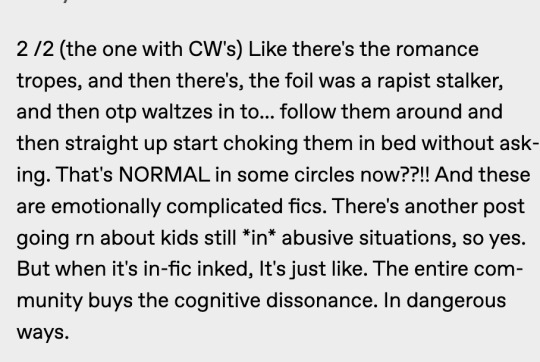

So I'm not familiar with your example or the post, but if that's a new fandom trope re: an in canon rapist stalker, for me personally, if tagged appropriately, I'd fall under YKINMKATO, but it is seriously NMK. If untagged, I'd be side-eyeing hard. I realize that might not be where you fall at all, but regardless of my personal taste re: a fic or trend in fics, I am generally going to take most arguments about the dangerousness of individual fiction tropes (that are not based in marginalization, etc) with a pillar of salt. I don't know why that narrative is resonating with members of that fandom, but it is. If they're tagging it so that people know what they're getting...I wouldn't read it but I'm not going to be mad about them reading it, if that makes sense.
I sort of riffed off of some of what you mentioned up there but as a disclaimer I'm sort of thinking about big fandom trends and not so much talking about you but patterns lately that as a fandom quasi-old have been on my mind the past decade or so.
I'm always going to be super leery of the 'unlike myself, the feeble minded masses know not the effects of what they read and must be protected' slippery slope. It was a bad argument in the Middle Ages, when it was used to make vernacular literacy illegal, continued to be a bad argument in the 18th and 19thc when it argued that women and children were too weak-minded to read without mental and moral damage, and looks real familiar today in discussions about fanfic in particular but we see it in other moral panics of the 80s, 90s, and aughts, re: video games, rap, rock and roll in the 80s, etc.
anyway.
For me, the tagging is a key courtesy but while that fic arc might make me X out... that's kind of it for me. I am not then going to say that it is dangerous for other people to read it and assume that I see the "problem" but they don't or that if they have cognitive dissonance, it's one they can't think through. They might enjoy it as fiction and also see that it's not a thing they'd want in real life, much like... most of what we consume in media.
One thing that complicates a lot of this further is that there often are ... in-fandom givens that newcomers or people outside judge very differently and which consequently don't port well to other fandoms.
So for example, in Marvel comics fandom, identity porn is extremely common because of all the secret identity in early comics, and that's a sort of beloved aspect in a lot of those fandoms and comics. Friends who write and move into other fandoms report back that similar storylines in other fandoms get flamed if they don't get tagged to high hell for noncon and dubcon bc of the identity issues, which... at least when I was more heavily reading in comics fandom... just wasn't an issue because of the givens of the content matter, but ... that's not a portable assumption when you leave those confines.
idk, but I think a lot of times we tend to take more complicated issues of personal response and also issues of what makes some narratives, characters and fandoms attractive to people at certain times to people and reduce it to the same reductive good/bad, healthy/unhealthy, etc. binarisms that are great for setting up false dichotomies of us/them, but not great for conversations or even just saying yeah that's not my thing and I don't get why it's yours but how about that rich tapestry of life, eh?
I think part of what we're seeing right now is the loss of insular fandom community and communities with internal vocabularies and shared norms colliding with an overall cultural hard swing into paternalistic and fascistic discourses about sexual and moral purity that means that often we see a necessary conflict where there is a difference of opinion.
Meanwhile we have people actually framing true dehumanization and violence as a difference of opinion. I just think we've got our polarities and priorities flipped on a lot of this, probably largely because we're super anxious and feel powerless about our ability to effect change in the big picture issues right now, so there's a lot of punching across and down so we can at least feel like we're winning some kind of victories, but... I think when we do that we're just kind of playing into the big picture on the wrong side a lot of the time.
tl;dr totally agree that self-contradictory fics are obnoxious, and that sometimes fandom narrative tics can squick me, but I'm suuuper leery of labeling them dangerous even if they make me say oh hell no.
6 notes
·
View notes
Text
Cheerful, Confusing, and A Little Scary – Loss of Life Album Review
From 80s synth pop to existential power ballads.
The awkwardly satirical duo known as MGMT are not just a source of internet memes (the “Electric Feel” bass cover incident) and TikTok hits, but are responsible for some of the iconic songs of the past two decades, such as their 2007 single “Kids”, which still haunts the world today.
Over the years, VanWyngarden and Goldwasser’s project has earned the reputation of being slightly odd and “not your typical pop group”. The golden duo do not shy away from themes of disdain for our current cellphone society, expressing their snarky comments through either cheerful pop or disorientating dissonance. This “weirdness” came out especially strong on their 2018 release Little Dark Age, which featured peculiarities such as “She Works Out to Much” and “When You Die”. After a solid career of mocking the music industry – and declaring their love for Brian Eno – MGMT release their fifth studio album Loss of Life. Although, Loss of Life is still filled with references to a time long gone, the band shows maturity by taking stabs of satire and cynicism from their previous lyrical aspects, and work it into the nuances of the music.

Design by John Baldessari, Noses & Ears, Etc. (Part Two): Two (Flesh) Faces with (Blue) Ears and Noses, Two (Flesh) Hands and Hobby Horse, 2006.
The album kicks off by pestering the listener with an immediate nostalgia inducing prelude on “Loss of Life (part 2)” – We’ll come back to discuss the “part 2” and why this would be in an opening track title? The first of many sly shenanigans. The track starts out with a gritty vinyl sound that introduces a music box tune, accompanied by robot-like voice that speaks of uncanny observations of our world and tells the story of a Welsch bard. It is somewhat reminiscent of “Fitter Happier” by Radiohead, but more cryptic.
VanWyngarden recently explained that their earlier success had given them the freedom to focus more on the music for this record, and this becomes apparent throughout the musical arrangements. An example of this is the bridge in “Nothing Changes”, which offers a lovely intricate symbiosis between brass and synth, which builds up and down and finally flows over smoothly into the final section of the song.
Referencing to the sound of 2000 nostalgia, “Phradie’s song” exhibits the cynical attitude that MGMT is known for, but in a more sophisticated manner. The song starts out with a rather cheerful guitar strum, which is soon accompanied by the joyful ringing of bicycle bells and whistles, one again confronting the listener with looming nostalgia. There has been an internet trend going on of late 90s/early 2000 kids reminiscing about the aesthetics of their childhood era. “Phradie’s song” somehow captures this feeling of longing for childlike unawareness, reminding us that this is something we will never get back. The song then goes on as a lullaby and dissolves into something ungraspable. Comforting and threatening at the same time.
“I Wish I Was Joking” is another close gathering of oddities. The chords progressions border on eerie, and the constant unresolvedness tricks the ears. The song makes a reference to drugs, and the construction of its sonic body does in fact stimulate a feeling of still hanging out at an afterparty, while you should have gone home hours ago. Now you find yourself on a dirty couch, fighting a battle with gravity. This same anti-climactic feeling can be found on “Dancing In Babylon”, which features Christine and the Queens. This song lacks climax in the sense that it’s structure seems to tease a chorus, but never actually finalizes this promise.
Lastly, to lay on the Brit of Britpop, the closing track of the album “Loss of Life” (there is it), the album returns back to its opening music box melody. However, this time it finally gives us the resolve that we have been waiting for the entire album in a cosmic dreamscape Stg. Pepper-esque goodbye. It holds on to the uncomfortable nostalgia that runs through the entire album like a thread, but intermixes it with glimpses of hopeful sounds – such as the return of the brass. Only to resolve into some demonic sound and send us back to “part 2”, where it all began. Suggesting that the album is a circular never ending experience.
Instead of communicating their message through words, MGMT have embodied the lost souls of postmodernism in their music, showing real maturity and leaving me confused and scared of a potential “Bubblegum dog” following me in my nightmares. Yet it should be considered that this was a close analysis of the album, which I have listened to multiple times in a row. And what may be the biggest trick of all, is that if you were to listen to it casually, it can also pass a just a pleasant pop record. The pastiche and satire have been integrated in such a subtle way, that it does not stand in the way of the “listenability” of the album. And although the record has been received with mixed reactions, the duo has shown incredibly musical integrity. And for those who stand with one foot outside the borders of reality, Loss of Life might help you slip out the other one as well.
0 notes
Text
The Beginning
I have always loved fashion & it’s all I ever think about. I daydream about shoes or vintage RedLine Levis that just aren’t made like that anymore. Sometimes, I daydream about the dichotomy of the Hermès Birkin. That it comes with its own custom made raincoat but how Jane Birkin’s own Birkin overflowed with countless nicknacks, womanhood treasures & probably never once wore its chic raincoat. How walking in kitten heels reminds me of my first pair of heels, the plastic princess ones. Regardless of what it is, fashion is running through my mind 24/7. If someone lends an ear to me, I will talk it off with obscure fashion references or ponder about passers-by & where they might have gotten that coat. Is it vintage? Is it her grandfathers or her partners grandfathers? Is it from a curated thrift store somewhere on the westside & she overpaid for it? Even worse, could it be fast fashion? I know it sounds crazy but that is why I love fashion. Just like any form of art or self expression, there’s always a personal story attached to the piece. So, how did I get here?
My love for fashion comes from a culmination of events. I grew up in hair salons as my mother is a hairstylist & has been for the past 30 years. My mother has always worked hard which led to many days, nights & weekends spent in the salon.This was long before Ipads and we only had one gameboy growing up. A Gameboy Color that my older brother took ownership of the moment we got it. So, to keep myself busy at the salon, I would help with cleaning tasks, ripping foils, entertaining her clients or, on occasion, I would get my nails done. (I once got a pedicure & each of my toes were painted a different color of M & Ms) When those weren’t available to me or I got bored, I read magazines. Back in the late 90’s / early 2000’s, one of the ways you picked your hairstyle was out of these magazines. Either gossip, fashion or hairstylist magazines. The piles of magazines at the salon were high and ever evolving. I would get lost in these magazines, staring at the images & letting my mind wander. About the scenes, the vibe, the fashion, the makeup and of course, the hairstyles. All the glitz & glam. I was entranced by photography, specifically fashion photography. After the salon, we would head home where I would watch the show that sealed my fate forever. Lizzie McGuire.
The Second Event: The Lizzie McGuire show had me in a chokehold. The costumes in that show brought fashion into my life. The one costume that changed me? Season 1, Episode 2. It’s picture day, Lizzie’s mom is making her wear a unicorn sweater while Lizzie’s BFF, Miranda, comes to school in THE outfit. An orange, sleeveless crew neck, and a zebra print midi skirt. Unfortunately, it’s what the school bully was also donned in. Something about this outfit stuck with me. It was the first time I connected with clothing and saw something that I would actually WANT to wear. I was 6 years old. Every episode from there on was magical. It was introducing trends and how to dress in a way that was unapologetic and authentic to me. Thank you to Costume Designers Monique Prudhomme & David C. Robinson for sparking this and creating a muse for my childhood.
The Main Event: My mom’s closet. Well, it started in my mom’s handbags when I was just a toddler. Adored with a binky in my mouth, I would climb up to wherever my mom set her purse down. I would sit there for what felt like hours and just rummage around in there. I would pull out her lipstick, open it and probably rub it all over my face before returning it back to its home. Her compacts, cash, trinkets and Ricky Martin checkbook all had their time outside of the bag. Eventually, I would be caught red handed and be put back with my dolls to play with. Once I was fully mobile, probably 4 years old, my mom’s closet was next on my list. I would pull out everything. She kept her prom dress from the 80’s that I would waltz around in. With heels on and any accessories I could reach. Just pretending that I was in those photos from the magazines. My mom’s jewelry was phenomenal. She grew up in the 80’s and was a fashionista herself. She would tell me, “Everyday was a fashion show for me in high school. I had endless amounts of Guess Clothes & everything was Name Brand.” 80’s Guess aka a work of art. Perfectly captured the teenage youth of that time to tell us their story through fashion for the years to come. Everyday has been a fashion show for my mom, it didn’t end in her high school years. Anyways, back to her Jewelry. There I was, with all three of her jewelry boxes open, sitting on her closet floor, picking things out and hearing all the stories behind each piece. “Your dad bought me these earrings” or “ Your granny got me that for my birthday”. These memories are seared into my brain forever. These moments made me love fashion and see it in a new light. A light that connected with me and shined on me. A light that showed me the stories that pieces of fashion can tell.
1 note
·
View note
Text
The iconic "Baggy" trousers that were so popular in the late 80s and early 90s are back in fashion again, but this time they're worn straight, not slouchy. And of course, no discussion of this style would be complete without referencing the legendary Manchester band, The Smiths.
The Smiths were known for their legendary frontman, Morrissey, who helped mainstream the Baggy aesthetic in 1985 when they released their iconic single, “How Soon Is Now?” Worn with distressed sweaters, tattered jackets, and un-ironed shirts, the group’s signature look was Baggy, slouchy trousers. Fans took this look and made it their own, with thrift-shop clothes, sometimes even Cardin-style, flared trousers.
Now, thirty years later, we can find remnants of the original Baggy aesthetic in today's trends. But the Baggies have been updated in the fashion world and fit straight from the knee to the ankle. Designers like Off White, Public School, and Offcutts have taken The Smiths’ lead and modernized the look, adopting the classic Baggy, and adding slick fabrics and fitted silhouettes.
So why the shift from the slouchy originals? Looks that fit straight have always been around, but the update to the classic Tapered Baggy look creates an impression of a tailored fit, bringing the look into the 21st century. So while The Smiths’ influence remains, the slouchy Baggy look has evolved to keep up with modern fashion trends.
0 notes
Text
The Trend Reborn: Baby Tees
Fashion is cyclical, and trends often make a return, either with a nostalgic vibe or a modern twist. One trend that has been gaining popularity in recent years is none other than the baby tee. Once a staple of '90s and early 2000s fashion, these tiny, cropped tops have made a comeback. In this post, we'll explore how baby tees are making a resurgence and how to incorporate them into your wardrobe for a trendy, stylish look.


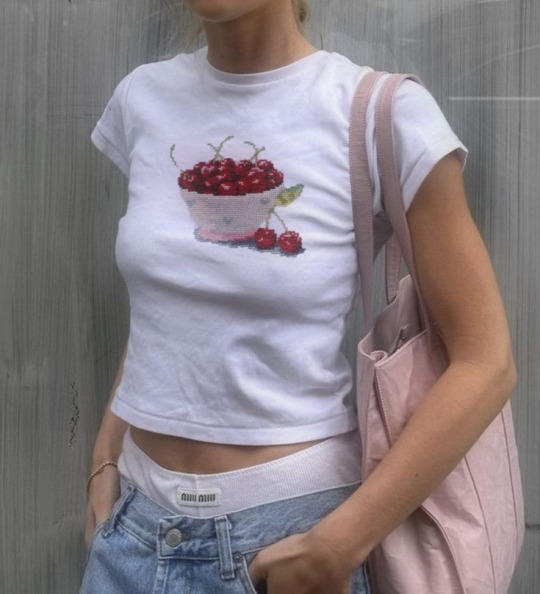
Kiss muah Retro Inspired Baby Tee Y2K Aesthetic - Etsy
imgurl:https://i.pinimg.com/474x/87/80/44/87804480077fe0f9ef6ed5c01fe9b9a4.jpg - Bing
Baby Tee Life is a Bowl of Cherries Baby Tee Coquette Summer - Etsy
The Revival of Baby Tees!
Baby tees, also known as crop tops or cropped T-shirts, are characterized by their short length, often ending just above the navel. They were a hit in the late '90s and early 2000s, embraced by pop culture icons and fashion-forward teens alike. The trend eventually faded away, only to re-emerge in recent years. This trend is experiencing a revival for several reasons including; nostalgia, versatility, body positivity, and celebrity influence.

(1914) Pinterest

(1914) Pinterest

(1914) Pinterest
How To Style Baby Tees:
Now that you know why baby tees are back in fashion, let's explore their versatility and some stylish ways to incorporate them into your wardrobe:
To continue to ride the late 90s and early 2000s wave baby tees can be styled with low-rise jeans, cargo pants, or flared leggings. In addition, skirts mini or maxi can be paired with these tees to create a flattering look!

f1bd2522d2389e6630cc5b5bc05eb0f7.jpg (719×1007) (pinimg.com)

403ed1a2ae30595cc2d1821a799a3d18.jpg (775×1200) (pinimg.com)

3a7f3a567cc6132aad463480f7b7e120.jpg (800×1200) (pinimg.com)

Do Not Disturb Baby Tee Y2K Clothing Graphic Shirt Cute - Etsy
Baby tees have made a remarkable comeback in the world of fashion, thanks to their versatility, nostalgic appeal, and the influence of celebrities and influencers! Whether you're looking to channel your inner '90s kid or simply want to experiment with a fun and youthful trend, baby tees are a fantastic addition to your wardrobe! So, embrace the baby tee trend and make it your own in this era of fashion revival!
Tune in next week for our next trend report!
0 notes
Text
Shinobi III

The late '80s and early '90s fucking loved ninjas, so of course they were in a lot of media of the time. Videogames no exception, and to me the Shinobi series were always indicative of this trend; plus iconic in their own way.
The first game, an arcade title, was occasionally unfair and brutal but completely memorable. The second ('Revenge of' or 'The Super' Shinobi, depending on region) was an improvement in pretty much every way, offering both a meticulously-balanced action platformer that helped give the SEGA Megadrive a strong launch lineup; and an artistic commentary on East-versus-West attitudes and stereotypes.
Number three eschews the high art in favour of schlocky ninja action, and absolutely excels with it. This being the nineteen-nineties, the stoic and considered pace of the first two games is replaced with a dash-in-and-katana-them-in-half attitude, bolstered by surfing robots and a drop-kicking horse mount. I'm not kidding, such things made my teenage self exclaim "awesome!" thirty years ago, and my adult self hasn't changed their mind one iota since. That's why I play through every now and then, and why I played through it another time today.

Even today, the game's pace and fluidity makes it an absolute joy to blast through; seven levels, split into two discernible halves with a boss at the end; and just enjoy the hour-long ride whilst I'm there. Protagonist Joe Musashi (yeah, really) dashes, blocks, somersaults, divekicks and walljumps the environments with aplomb; although maybe not as stop-on-a-dime responsive as modern (circa 2023) platform action games, there's a nonetheless a feeling of weight to the proceedings that makes it satisfying to chain the moves together -- you aren't just playing as a ninja, you are the ninja.
To top this off, it looks and sounds amazing. It's a great experience all around, offering a perfectly-pitched challenge that may sap a few lives but never overly-frustrates; unless the difficulty is turned up. And even then, it's totally learnable and designed for it.
I feel like it's customary to say something negative about the game to 'balance' the positives? I didn't like waiting for some platform cycles on 7-2. There you go. Motherfucking game is almost perfect. 5/5
#sega#genesis#sega genesis#megadrive#mega drive#sega megadrive#sega mega drive#16 bit#retrogames#retro#shinobi#super shinobi#shinobi iii#shinobi 3#ninja#1990s#1993#90s#nineties
1 note
·
View note
Text
Thoughts about, ‘the 90s look’ from an older fuck that was a kid during them.
It was like every year of the 90s had its own aesthetic and that may just be solipsism on my part coinciding with going from age 6 by 1990 to age 16 by 2000, but holy fuck.
1990 to early 1992 felt like its own decade, honestly. Just, spiritually, the America of 1990 to the fall of the Soviet Union may as well have been a different movie. And not unlike Stephen King’s It, when it fell, it’s like the USSR just disappeared off of our radars. Dads and uncles didn’t talk at length about the threat it posed anymore around us, because it wasn’t a potential inevitable. Dads and uncles and grandpas and older cousins had the sense to only talk about it again when we weren’t there, because of the shit occurring in the post-Soviet era.
So just like that, for kids growing up in the 90s, the Soviet Union was a thing and then suddenly it was not. A blurb in the headlines or evening news about Eastern Europe struggling after the threat passed.
I bring this up in a post about style and aesthetic because you can’t talk fashion without also talking subcultures, and if you talked to a goth or a mall kid in the late 80s or early 90s, you’d get similar but very different things they had concerns about and knowledge of.
Like the neon colors of 80s fashion. Why? Because they wanted to be garish and bright and as colorful as possible, with just the feintest hints of LGBT themes to them. A kind of noblebright cynicism where if we were all going to disappear into radioactive vapor because General Vodkavich decided to roll out the 80,000 armored personnel carriers through western Europe, they wanted to disappear in radioactive fire looking good and partying hard.
But then that gave way a few years later to kids that preferred aesthetic so dark and morose that a few people secretly wondered if maybe something was wrong with them.
And that gave rise to a kind of cynical, sarcastic “just ironically living to live” sort of attitude, which led into weird geometric patterned fashion choices and dark colors.
This “who gives a fuck” sarcasm and smarmy defeatism seemed to go arm in arm with the threat of nuclear war passing, but rising awareness (some would say, misinformation or disinformation) about global warming and pollution and the current trends and pessimism about any sort of progressive change to stop it thanks to capitalism, corporatism and greed, led to depression. It kind of hung in the air in my peer groups and I remember a lot of that dominating conversations. And fashion choices were often a reflection of what we were feeling at the time we went to buy new clothes- or in some of their cases, makeup and hair styling.
Maybe I’m just projecting, but attitudes shifting seemed to go arm in arm with these fashion trends from the people I remember wearing them. But, this is what I remember. Going from pastels and bright colors in the 80s to 90s weird geometric shapes and asymmetry and darkness to contrast.
0 notes
Text
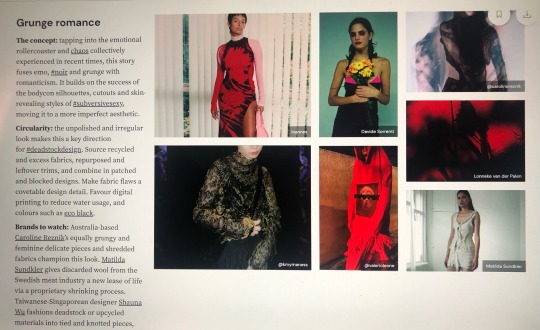
Researching My Original Chosen Trend -
My chosen trend has been titled 'Grunge Romance' by the WGSN company and is a hybrid of the subcultures emo/grunge and romanticism. The reason for choosing this trend and why is resonates with me is because I love the alternative style and how music is a clear strong influence of the subculture. I also love how delicate fabric is used in a unconventional way to create outfits that are seen as beautiful but with dark, emotional features and connotations.
The style 'Emo' started as a music genre that took hardcore music but put emotional lyrics over them. Instead of being aggressive like hardcore bands, these types played into emotion, vulnerability, and femininity. This led to the fashion style having a more feminine aspect with the heavy makeup, tight clothes, and long hair. 'Grunge' has roots in 1990s rock, like Nirvana and The Grateful Dead. It focuses on a dissatisfaction with modern society and dirty visuals. It is a more casual style that can almost appear not put-together. Many grunge artists were poor, so a lot of the style comes from thrift stores- baggy shirts, ripped jeans, and combat boots or Doc Martens. The influences of 'Romanticism' brought forth fashion trends from the past- such as neck ruffs, slashing (the process of cutting away fabric to reveal what is beneath), and a variety of medieval sleeve styles. Sleeve style were both long and short.
Grunge fashion began to break into mainstream fashion in mid-1992 and peaked in late 1993 and early 1994. Courtney Love has been considered one of the top ten women who defined 1990s style by popularizing the "kinderwhore" style. The kinderwhore look consisted of torn, ripped tight or low-cut babydoll and Peter-Pan-collared dresses, slips, heavy makeup with dark eyeliner,barrettes, and leather boots or Mary–Jane shoes.
Kurt Cobain was the male style icon of the subculture in the late 80s and early 90s; he made the cardigan, messy long hair, striped sweaters, and flannels popular. Even though the grunge movement died down in 1994 after his death, designers have continued to draw inspiration from the movement.
The grunge look evolves again in the mid 2000s with trends such as low-rise jeans, denim jackets, band shirts, knee length jean shorts, crop tops, cargo pants, trench coats, leather jackets and band shirts. Grunge fashion also embraced the influence of the punk adjacent music scene during this time. Some grunge style icons at this time were Avril Lavigne and members of the band The Strokes. Grunge appeared as a trend again in 2008, and for Fall/Winter 2013, Hedi Slimane at Yves Saint Laurent brought back grunge to the runway.
During the mid 2010s we started to see mainstream brands like Forever 21, H&M, Urban Outfitters, and Nordstrom selling grunge basics like ripped jeans, usually skinny jeans, flannels, skirts, boots, tights, and sweaters. During this time, grunge evolved into a more chic look for women but for men at this time didn’t change too much. It was typical for the alternative/grunge to wear flannels on top of a band shirt with jeans and some converse. Today, we see brands like Brandy Melville start up and embrace the grunge looks from the past during this time in a modern and less expressive way.
These past few years have been influenced by cargos and wide legged trousers. In 2021, grunge pieces would be oversized cardigans or sweaters, a flannel, a few band shirts from the 90s, cargos, mom jeans, doc martens, and converse.
In terms of the industry and products today, this style of clothing is still seen in shops such as Urban Outfitters and vintage stores, where a more alternative style is celebrated. Being a less mainstream trend, Grunge Romance is more of a niche subculture.
Jane Bradbury (2020) Evolution of Grunge Fashion Available at: https://www.crystalcrushmagazine.com/fashion/5-25-2021/evolution-of-grunge-fashion. [Accessed on 3 January 2023]
Jynx Zander (2022)
THE ULTIMATE GUIDE TO GOTH, PUNK AND EMO STYLES Available at: https://www.political.fashion/posts/the-ultimate-guide-to-goth-punk-and-emo-styles-pf [Accessed on 3 January 2023]
In this particular trend, you can see that the general shape of the clothing varies from loose to tight fitting, rather than following a strict rule. As stated in the description 'the unpolished and irregular look makes this a key direction for 'deadstock design' which leads to the main materials being 'recycled and excess fabrics, repurposed and leftover trims, and combine in patched and blocked designs.' These materials include cotton, lace/mesh, cut and sew, knitwear, partywear, hosiery, denim.
Sara Maggioni (2022) Womenswear Forecast A/W 23/24: Creative Reset. Available at https://www.wgsn.com/fashion/article/93016 [Accessed 3 January 2023]
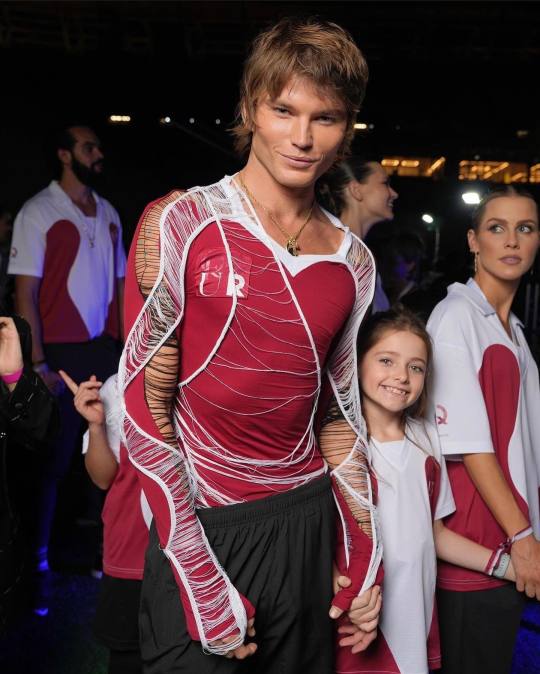
Caroline Reznik’s -
As referenced on the WGSN website, Caroline Reznik is a designer who uses elements of this trend in her collections. She fuses the grunge aesthetic with delicate material and feminine shapes to communicate this trend. Above is an example of one her of her pieces.
Caroline Reznik (2022) carolinereznik Available at: https://www.instagram.com/carolinereznik/ [Accessed 3 January 2023]

Matilda Sundkler -
Another designer referenced on the WGSN website for embracing this trend is Matilda Sundkler. She makes her fabric from the discarded wool thrown away by the meat industry instead of killing more animals specifically for wool. This is a much more sustainable way of using animals for recourses. Above is an example of a dress designed and made by her and her company.
Matilda Sundkler (2022) sylvi_sundkler Available at: https://www.instagram.com/sylvi_sundkler/ [Accessed 3 January 2023]

Shauna Wu -
The third designer referenced is Taiwanese-Singaporean designer Shauna Wu. She uses deadstock or upcycled materials to create tied and knotted pieces, inspired by ceremonial Chinese knotting practices, and then dyes them with ingredients found in traditional Chinese medicine. The use of upcycled materials means her process of manufacturing is much more sustainable than most. Above is an example of her work.
Shauna Wu (2022) Shauna Wu Available at: http://shawnawu.com/ [Accessed 3 January 2023]
1 note
·
View note